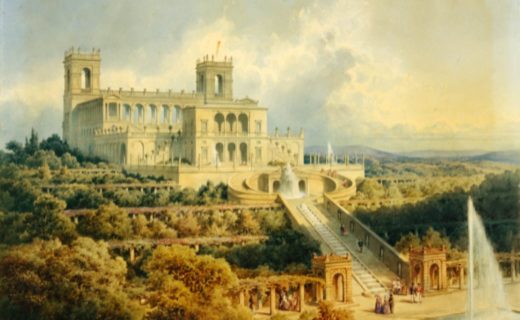Frederick William IV’s Italian Dream
Construction work on the Belvedere – Pfingstberg began in 1847, commissioned by Frederick William IV. At the time the Prussian king did not know that he would not live to see its completion in 1863. Nor did he suspect that, in the end, the palace would never quite look as he had originally imagined it.
Magnificent building with a view
Initially, the king was happy just to have acquired the high ground land for his Pfingstberg project. It was still called “Judenberg” because of the Jewish cemetery located on the hillside, and it was already a popular vantage point overlooking the garrison town of Potsdam. His predecessors, Frederick William II and of Frederick William III, had also imagined embellishing this same site with a magnificent building.
Italy as an inspiration for the Belvedere – Pfingstberg
Frederick William IV’s palace with a view was intended to manifest an Italian dream in Potsdam. It was influenced and inspired by the Villa Medici in Rome with its soaring towers, the Villa D’Este in Tivoli with its playful water fountains and terraces, and the Villa Farnese in Caprarola with cascading waterfalls and rounded flights of stairs. The king had returned from his travels to Italy full of enthusiasm and inspired by the architecture that he had seen there.
Construction of the Belvedere Palace in politically restless times
Ludwig Persius, Friedrich August Stüler and Ludwig Ferdinand Hesse were involved in the palace’s architectural planning, although Persius died unexpectedly in 1845, before construction began.
The Belvedere was built in only five years – during the politically troubled revolutionary period around 1848. In 1852 work on the building was interrupted in favor of erecting the Orangery Palace at Sanssouci. It was not until 1861, following the illness and subsequent death of Frederick William IV, that his brother William I brought work on the building to a more limited completion than had been intended. In the years that followed the royal family used the palace to take their afternoon tea.
Never completed, but still a magnificent and prestigious Prussian building
The “unfinished building” by no means had to forfeit its striking appearance. Even today the Belvedere – Pfingstberg (a UNESCO World Heritage site) still surprises visitors with its impressive architecture, whose bright sandstone conceals the fact that it was built north and not south of the Alps. Situated more than 100 meters above sea level, tens of thousands of visitors annually enjoy “Potsdam’s most beautiful view” from the palace towers.
Learn more about the history of the palace in the permanent exhibition at the Belvedere – Pfingstberg.



